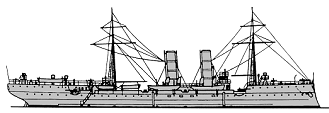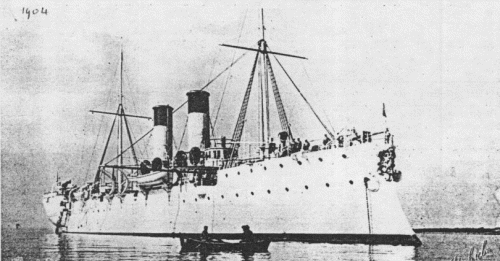

Amur 1901
| Name | No | Yard No | Builder | Laid down | Launched | Comp | Fate |
| ΐμσπ [Amur] | Baltic Wks, St. Petersburg | 1898 | 8.11.1898 | 1901 | sunk 18.12.1904 | ||
| Ενθρει [Yenisey] | Baltic Wks, St. Petersburg | 1898 | 20.5.1899 | 1901 | sunk 11.2.1904 |
|
Displacement normal, t |
2590 |
|
Displacement full, t |
2800 |
|
Length, m |
91.4 pp 92.7 oa |
|
Breadth, m |
14.9 |
|
Draught, m |
5.20 max |
|
No of shafts |
2 |
|
Machinery |
2 VTE, 12 Belleville boilers |
|
Power, h. p. |
4900 |
|
Max speed, kts |
18 |
|
Fuel, t |
coal 650 |
| Endurance, nm(kts) | 3600(10) |
|
Armament |
5 x 1 - 75/48 Canet, 10 x 1 - 47/40 Hotchkiss, 450 mines |
| Complement | 304 |
Project history: Mine transports with the general appearance of small cruisers that served as minelayers in the Russo-Japanese War.
Modernizations: None.
Naval service: One of the most successful of all mining operations was carried out by Amur on 14 May 1904 when she laid a field of 50 mines which sank the Japanese battleships Hatsuse and Yashima. The Yenisey was sunk by one of her own mines 11.2.1904 off Dalniy and the Amur was sunk on shallow water by Japanese 280mm howitzers at Port Arthur 18.12.1904 and finally exploded by own crew 2.1.1905 to avoid capture by Japanese.

Yenisey 1904
© Ivan Gogin, 2014